14 birds to watch for on Buzzards Bay this winter (and where to see them!)
Sure, winter can be a bit chilly. But if you venture outdoors during our coldest months, you’ll find a vibrant variety of birds that visit Buzzards Bay.
Winter offers incredible opportunities for birding and wildlife watching here in southeastern Massachusetts. Many different species of birds that migrate along the Atlantic Flyway settle here for the winter. Some of these species we see here in winter spend their summers in the Arctic, which means they’re only here this time of year. Searching for our winter visitors can be a fun diversion as temperatures turn chilly, and the fact that these birds usually aren’t around the rest of the year provides a little extra incentive to bundle up and get outside.
In addition to the usual robins, mallards, sparrows, and starlings, here are 14 birds you might see this winter, and some suggestions for places you can go see them. And remember, this list is just the beginning — bring along a field guide and see what other species you can find!
1. American Wigeon (Anas americana)
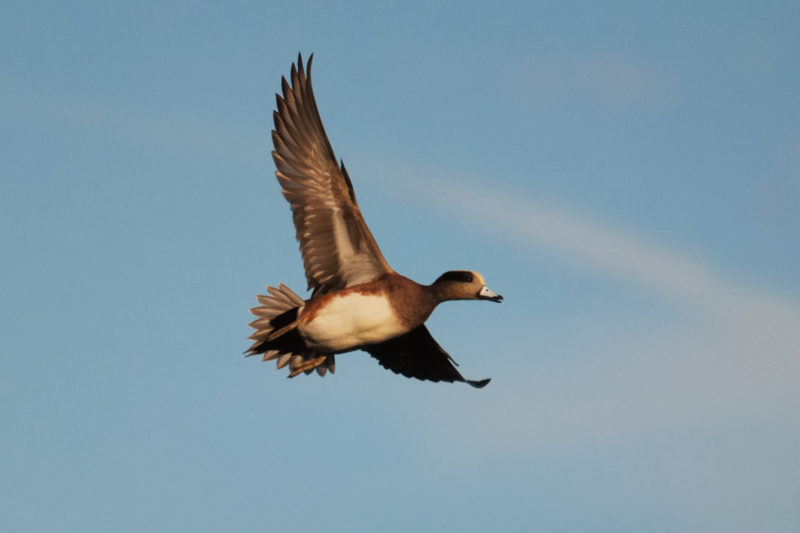
American wigeons can be identified by their small, gray bill. (Image: hjhipster/Flickr)
American wigeons are dabbling ducks, which means they feed at the surface of the water instead of diving underwater. American wigeons eat more plant matter than other species of dabbling duck, perhaps because they often leave the water to feed in fields.
The American wigeon has a small, gray and black bill. Males can be distinguished by their white foreheads, which is why this species was once called “baldpate.” They favor shallow freshwater wetlands. Look for them in places like Sippican Harbor or along the Agawam River in Wareham until April, when they return to Montana, Idaho, and North Dakota for the summer to breed.
2. Brant (Branta bernicla)
If you see a goose that doesn’t quite look like the common Canada goose — a little smaller, a little darker — then you may have spotted a brant. Brants are great travelers; they nest farther north than any other goose, and when they migrate they fly at altitudes of several thousand feet high.
In the winter, brants visit Buzzards Bay to feed on eelgrass, and can be seen in flocks along the coastline at places like Demarest Lloyd State Park in Dartmouth, West Island in Fairhaven, and New Bedford Harbor.
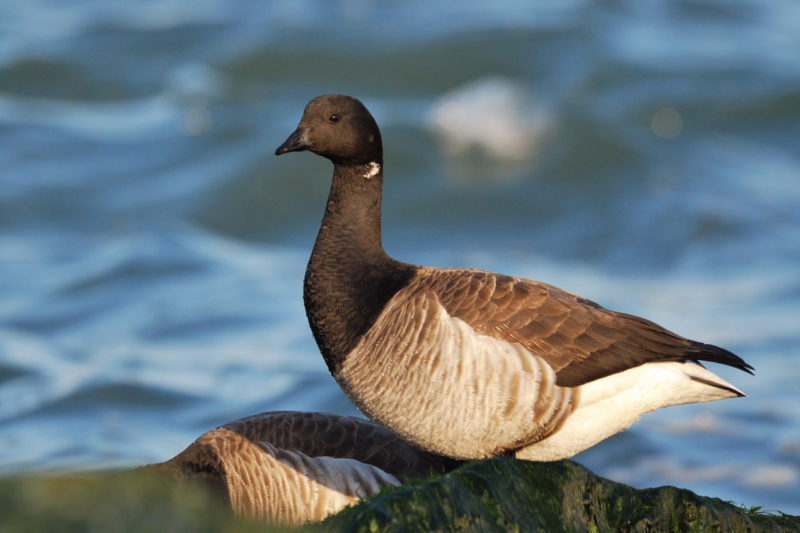
Check the coastline of places like Dartmouth, New Bedford, and Fairhaven for flocks of brant geese. (Image: hjhipster/Flickr)
3. Bufflehead (Bucephala albeola)
One of our smallest wintering waterfowl, buffleheads are chunky little ducks with a striking appearance. Males have a large white patch on the back of their puffy head, and females have a white smudge on their cheek. They may have evolved their small size to fit in their nesting holes, created in tree trunks by large woodpeckers.
Buffleheads are diving ducks, bobbing in and out of the water in search of insects and shellfish in sheltered areas along the coast. Look for them in places like Little Bay and Nasketucket Bay in Fairhaven, Sippican Harbor in Marion, Red Brook Pond in Bourne, and along the Cape Cod Canal.
4. Common Eider (Somateria mollissima)
With their distinctive wedge-shaped head and bill, common eiders are another winter duck that’s simple to identify from land. The common eider is the largest duck in the northern hemisphere. Like most other duck species, the males are colorful whereas the females are a dull brown color.
Although eiders are sometimes seen here in summer, they’re most abundant in winter. Flocks of hundreds – even thousands! – of eiders can be spotted in places like Woods Hole, Horseneck Beach and Gooseberry Island, and at the head of the Bay and in the Cape Cod Canal.
5. Common Goldeneye (Bucephala clangula)
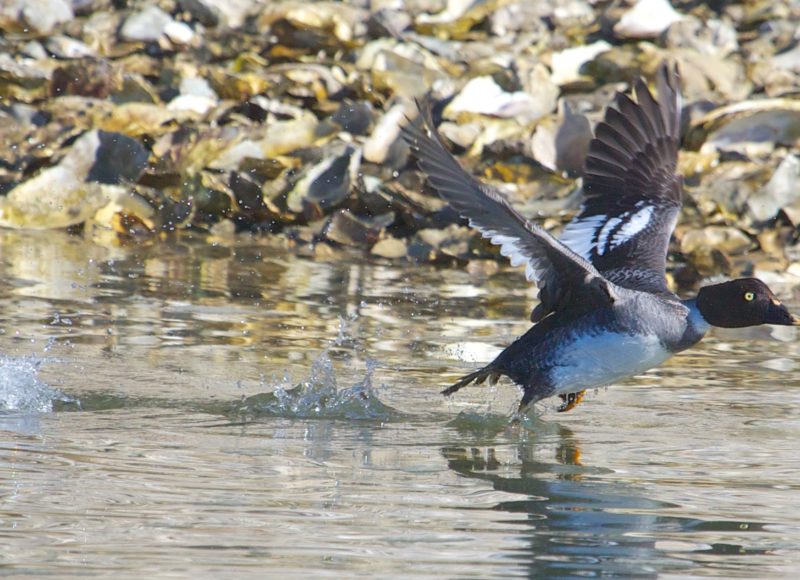
Common goldeneyes are named for their bright yellow eyes, which stand out against their dark head. (Image: Rick Derevan/Flickr)
Named for their piercing yellow eyes, common goldeneyes actually transition through a series of eye colors: from gray-brown when they’re hatchlings to purple-blue, blue, and blue-green before changing to their golden eye color as adults.
The common goldeneye migrates south later than other ducks, and so you may not see one until after other species, like buffleheads, have already arrived. Look for them throughout Buzzards Bay, from Gooseberry Island, West Island, and Nasketucket Bay across to Great Sippewissett Marsh, Quissett Harbor, and Woods Hole on Cape Cod.
6. Greater Scaup (Aythya marila)
Greater scaup are another diving duck, like buffleheads. Both males and females have a pale blue bill with a black tip, but that’s where their similarities end. Males have a completely dark head, chest, and tail with a lighter back and underbelly, whereas females are brown with a patch of white feathers around their bill.
The greater scaup has a lookalike relative, the lesser scaup, which is more commonly seen on inland waters. Look for flocks of scaup on the water at places like Fort Taber Park in New Bedford, Fort Phoenix in Fairhaven, Mattapoisett Harbor and Sippican Harbor, Little Bay Conservation Area in Bourne, and Woods Hole.
7. Green-Winged Teal (Anas carolinensis)
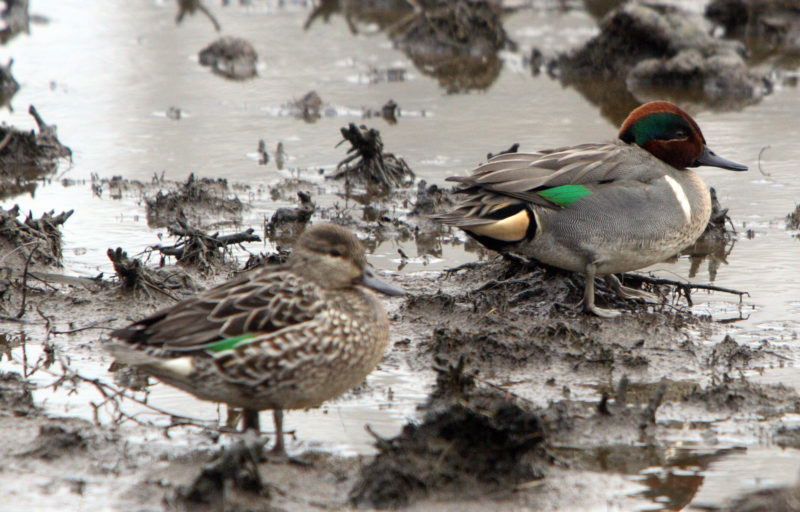
As their name implies, green-winged teals have a distinctive green patch on their wings. (Image: Rick Leche Photography/Flickr)
When watching for green-winged teals, look for the distinctive iridescent green patch on their wings. Otherwise, females look similar to female mallards, but smaller; males have a red and green head with a speckled chest and a white stripe up their shoulder. They feed in marshes and wetlands, dabbling at the water’s surface for seeds.
Green-winged teals aren’t always as common here as some other winter species, but there’s usually a few to find each year. Look for flocks of green-winged teals in marshes and mud flats at Allens Pond in Westport, Washburn Park in Marion, or Four Ponds Conservation Area in Bourne.
8. Hooded Merganser (Lophodytes cucullatus)
Mergansers can be differentiated from other ducks by their bills, which are thinner than most. The hooded merganser, however, is unique even among mergansers — this bird is the only living member of its taxonomic genus!
Hooded mergansers get their name from the feathering on their head, which forms a tall plume or “hood.” In their winter plumage, the hood can look a little bedraggled. They prefer shallow water, both in bays and inland on rivers, ponds, and swamps. Look for them in places like Great Sippewissett Marsh, along the Acushnet River at LaPalme Farm and The Sawmill, or along the Agawam River in Wareham.
9. Horned Lark (Eremophila alpestris)
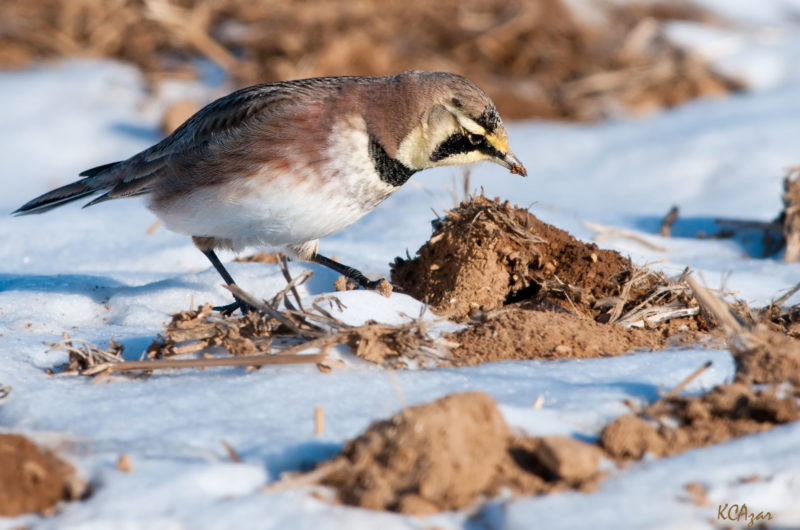
Look for horned larks in the farm fields of Fairhaven, Dartmouth, and Westport this winter. (Image: Kelly Colgan Azar/Flickr)
Around here, horned larks stay close to sea level. But these little songbirds are versatile, and can live at elevations up to 13,000 feet.
Horned larks gather in flocks in areas with bare ground and minimal vegetation, such as mowed or plowed fields. They have a yellow face with a black mask around the eyes and small black tufts of feathers that look like horns on top of its head. Look for them at places like Shaw Farm Trail, the Barney’s Joy area of Dartmouth, and around the Westport Rivers.
10. Purple Sandpiper (Calidris maritima)
The purple sandpiper nests in parts of the Arctic that are so remote, the bird is rarely seen except when it migrates south in the winter. They’re also unique because they typically mate in monogamous pairs, and the male will care for the hatchlings.
Look for this mottled gray sandpiper on rocky, wave-battered shores or foraging among washed-up seaweed at Gooseberry Island, West Island, and Woods Hole.
11. Red-Breasted Merganser (Mergus serrator)
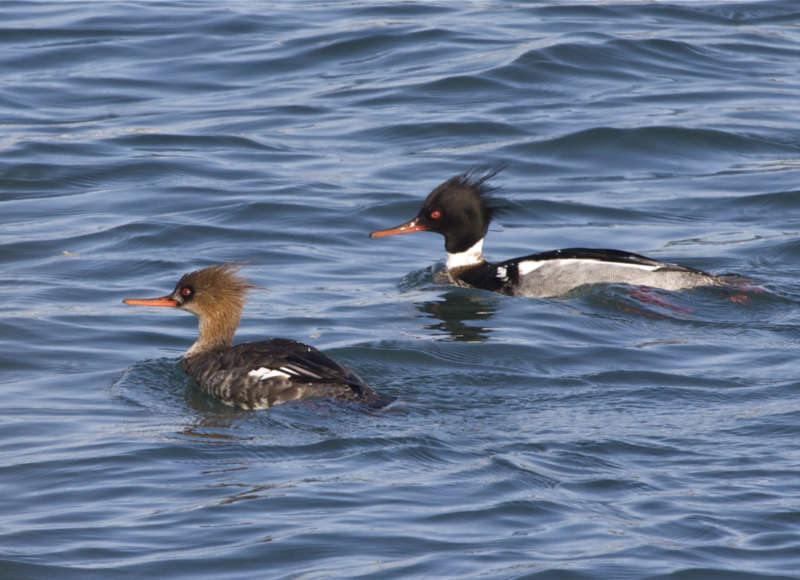
Red-breasted mergansers have feathers that look like spiky hair on the back of their head. (Image: Teddy Llovet/Flickr)
The red-breasted merganser holds the record for the fastest duck ever recorded, traveling at 100 miles per hour while pursued by an airplane! Like the hooded merganser, it has a thin bill, but instead of a “hood” on the back of its head, it has more of a spiky hairstyle. Look for its red-orange bill and white wing patch, which can be seen during flight.
Red-breasted mergansers appear all along the coastline in the winter, particularly near piers and jetties on salt water. Look for them in places like New Bedford Harbor, Allens Pond, the Cape Cod Canal, Quissett Harbor, and Woods Hole.
12. Snow Bunting (Plectrophenax nivalis)
With their white plumage and their tendency to travel in flocks, snow buntings have earned the nickname of “snowflakes.” These small songbirds feed on seeds, so they’re often found in fields, especially near the ocean.
Look for snow buntings this winter at places like Great Sippewissett Marsh, Nasketucket Bay State Reservation, Fort Phoenix, and Allens Pond.
13. Surf Scoter (Melanitta perspicillata)
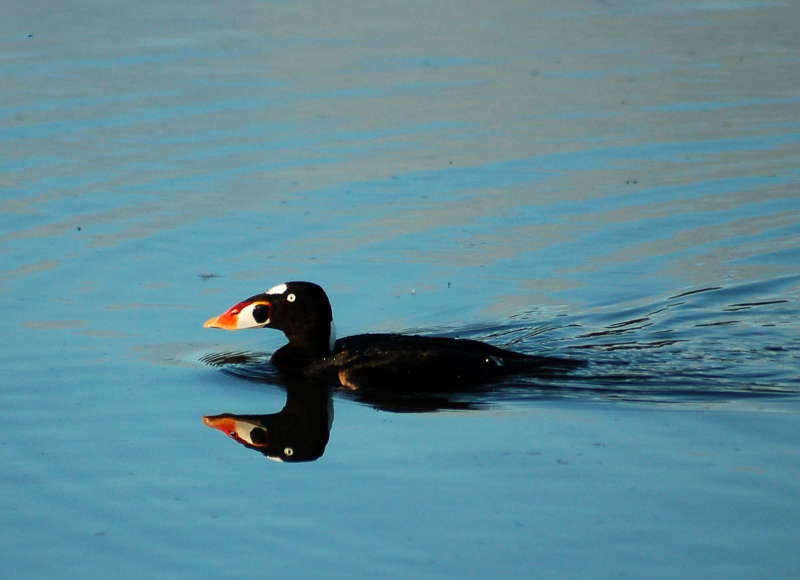
Male surf scoters stand out with their large, colorful bill set against a mostly black body. (Image: Dana Orlosky/Flickr)
The surf scoter is easily recognized because it has a truly distinctive look: males have a large, thick bill colored in white, red, and orange, with a black patch on either side. Hunters sometimes call this sea duck the “skunk-head coot.”
In winter, surf scoters are most frequently seen in shallow salt water, and they prefer areas where the bottom is pebble or sand. Look for them in places like Gooseberry Island, Quissett Harbor, and around Woods Hole.
14. White-Winged Scoter (Melanitta deglandi)
White-winged scoters are somewhat similar to their cousins, surf scoters. But you can distinguish a white-winged scoter by the white patch on its wings, which is visible in flight. Also, its head is almost completely black, with only a small white patch below the eye. Males have a knob on their bill, which has the same patchwork of black, white, red, and orange as the surf scoter.
White-winged scoters can be found closer to the shore than other scoter species, and they prefer areas near shellfish beds where they can feed on mollusks like clams and mussels. Look for them near Fort Phoenix, Gooseberry Island, West Island, and Woods Hole.